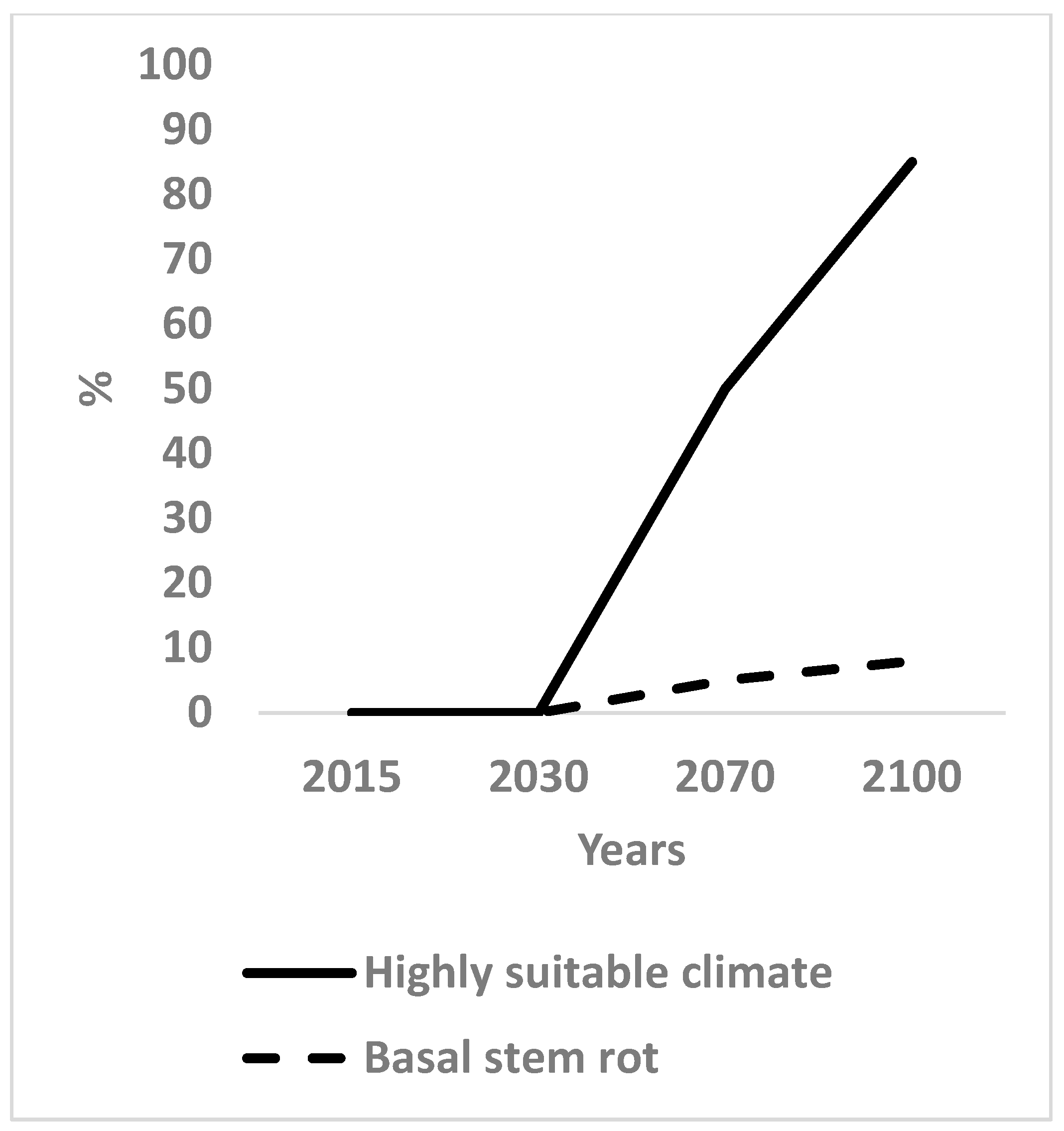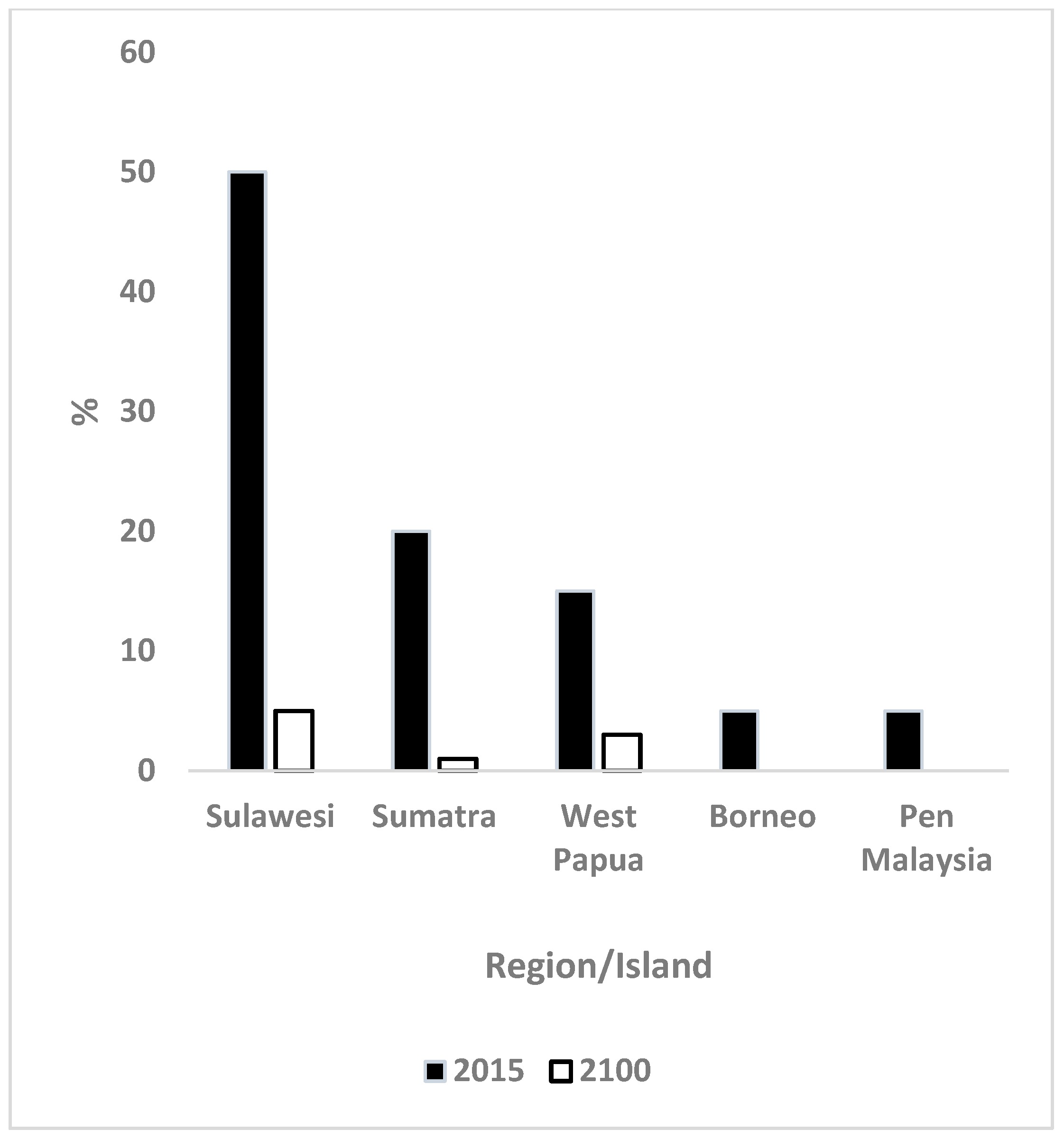Novel High-Suitability Regions for Oil Palm with Basal Stem Rot Estimations in Indonesia and Malaysia
Abstract
1. Introduction
2. Materials and Methods
3. Results
4. Discussion
5. Conclusions
Funding
Data Availability Statement
Conflicts of Interest
References
- Murphy, D.J. Carbon Sequestration by Tropical Trees and Crops: A Case Study of Oil Palm. Agriculture 2024, 14, 1133. [Google Scholar] [CrossRef]
- Tapia, J.F.D.; Doliente, S.S.; Samsatli, S. How much land is available for sustainable palm oil? Land Use Policy 2021, 102, 105187. [Google Scholar] [CrossRef]
- Pirker, J.; Mosnier, A.; Kraxner, F.; Havlík, P.; Obersteiner, M. What Are the Limits to Oil Palm Expansion? Glob. Environ. Change 2016, 40, 73–81. [Google Scholar] [CrossRef]
- Corley, R.H.V.; Tinker, P.B. The Oil Palm; Blackwell Science Ltd.: Chichester, UK, 2015. [Google Scholar] [CrossRef]
- Cassamo, C.T.; Draperc, D.; Romeirase, M.M.; Marquesa, I.; Chiulelef, R.; Rodriguesg, M.; Stalmansg, M.; Stalmans, M.; Partelli, F.L.; Ribeiro-Barros, A.; et al. Impact of climate changes in the suitable areas for Coffea arabica L. production in Mozambique: Agroforestry as an alternative management system to strengthen crop sustainability. Agric. Ecosyst. Environ. 2023, 346, 108341. [Google Scholar] [CrossRef]
- Grüter, R.; Trachsel, T.; Laube, P.; Jaisli, I. Expected global suitability of coffee, cashew and avocado due to climate change. PLoS ONE 2022, 17, e0261976. [Google Scholar] [CrossRef]
- Ogunkanmi, L.; MacCarthy, D.S.; Adiku, S.G.K. Impact of Extreme Temperature and Soil Water Stress on the Growth and Yield of Soybean (Glycine max (L.) Merrill). Agriculture 2022, 12, 43. [Google Scholar] [CrossRef]
- Paterson, R.R.M.; Kumar, L.; Taylor, S.; Lima, N. Future climate effects on suitability for growth of oil palms in Malaysia and Indonesia. Sci. Rep. 2015, 5, 14457. [Google Scholar] [CrossRef]
- Soares, J.R.S.; Ramos, R.S.; Siqueira da Silva, R.; Neves, D.V.C.; Picanço, M.C. Climate change impact assessment on worldwide rain fed soybean based on species distribution models. Trop. Ecol. 2021, 62, 612–625. [Google Scholar] [CrossRef]
- Ramirez-Cabral, N.Y.Z.; Kumara, L.; Taylor, S. Crop niche modeling projects major shifts in common bean growing areas. Agric. For. Meteorol. 2016, 218–219, 102–113. [Google Scholar] [CrossRef]
- Ramirez-Cabral, N.Y.Z.; Kumara, L.; Shabani, F. Global alterations in areas of suitability for maize production from climate change and using a mechanistic species distribution model (CLIMEX). Sci. Rep. 2017, 7, 5910. [Google Scholar] [CrossRef]
- Murphy, D.J. Agronomy and Environmental Sustainability of the Four Major Global Vegetable Oil Crops: Oil Palm, Soybean, Rapeseed, and Sunflower. Agronomy 2025, 15, 1465. [Google Scholar] [CrossRef]
- Forzieri, G.; Dakos, V.; McDowell, N.G.; Ramdane, A.; Cescatti, A. Emerging signals of declining forest resilience under climate change. Nature 2022, 608, 534–539. [Google Scholar] [CrossRef]
- Jorge, B.M.; Nobre, P.; Giarolla, E.; Baptista da Silva Junior, M.; Capistrano, V.B.; Malagutti, M.; Tamaoki, J.N.; de Oliveira, B.F.A.; Nobre, C.A. Amazon savannization and climate change are projected to increase dry season length and temperature extremes over Brazil. Sci. Rep. 2024, 14, 5131. [Google Scholar] [CrossRef] [PubMed]
- Romero-Ruiza, M.H.; Flantuab, S.G.A.; Tanseya, K.; Berrioa, J.C. Landscape transformations in savannas of northern South America: Land use/cover changes since 1987 in the Llanos Orientales of Colombia. Appl. Geogr. 2012, 32, 766–776. [Google Scholar] [CrossRef]
- Bharudin, I.; Ab Wahab, A.F.F.; Abd Samad, M.A.; Xin Yie, N.; Zairun, M.A.; Abu Bakar, F.D.; Abdul Murad, A.M. Review Update on the Life Cycle, Plant–Microbe Interaction, Genomics, Detection and Control Strategies of the Oil Palm Pathogen Ganoderma boninense. Biology 2022, 11, 251. [Google Scholar] [CrossRef] [PubMed]
- Paterson, R.R.M. Ganoderma boninense disease of oil palm is expected to significantly reduce production after 2050 in Sumatra if projected climate change occurs. Microorganisms 2019, 7, 24. [Google Scholar] [CrossRef]
- Paterson, R.R.M. Oil palm survival under climate change in Malaysia with future basal stem rot assessments. For. Pathol. 2020, 11, e12641. [Google Scholar] [CrossRef]
- Paterson, R.R.M. Depletion of Indonesian oil palm plantations implied from modeling oil palm mortality and Ganoderma boninense rot under future climate. AIMS Environ. Sci. 2020, 7, 366–379. [Google Scholar] [CrossRef]
- Anon. Available online: https://ontheworldmap.com/ (accessed on 2 February 2025).
- Brun, C.; Cook, A.R.; Lee, J.S.H.; Wich, S.A.; Koh, L.P.; Carrasco, L.R. Analysis of deforestation and protected area effectiveness in Indonesia: A comparison of Bayesian spatial models. Glob. Environ. Change 2015, 31, 285–295. [Google Scholar] [CrossRef]
- Nugraha, R.T.; Wendayandra, K.; Krisna, P.A.N.; Puspita, O.; Muslich, M.; Mardhiah, U.; Marthy, W. Evaluating the effectiveness of protected area management in Indonesia. Oryx 2024, 58, 474–484. [Google Scholar] [CrossRef]
- Jamidi; Muatho, M.I.; Nasruddin; Ismadi; Baidhawi. Agroclimatic suitability analysis for oil palm under projected climate in North Aceh Regency, Indonesia. J. Agrometeorol. 2025, 27, 177–183. [Google Scholar] [CrossRef]
- Go, Y.-H.; Tan, Y.-L.; Yiew, T.-H. Sensitivity of palm oil yield in Indonesia to climate change: Evidence from threshold cointegration models. In Environment, Development and Sustainability; Springer: Berlin/Heidelberg, Germany, 2024. [Google Scholar] [CrossRef]
- Syahid, L.N.; Luo, X.; Zhao, R.; Lee, J.S.H. Climate drives variation in remotely sensed palm oil yield in Indonesia and Malaysia. Environ. Res. Lett. 2025, 20, 044016. [Google Scholar] [CrossRef]
- Abubakar, A.; Ishak, M.Y.; Bakar, A.A.; Uddin, M.K.; Ahmad, M.H.; Seman, I.A.; Ching, L.M.; Ahmad, A.; Hashim, Z. Geospatial simulation and mapping of climate suitability for oil palm (Elaeis guineensis) production in Peninsular Malaysia using GIS/remote sensing techniques and analytic hierarchy process. Model. Earth Syst. Environ. 2023, 9, 73–96. [Google Scholar] [CrossRef]
- Paterson, R.R.M. Abubaker et al.’s paper concerning suitable future climate for oil palm in Peninsular Malaysia contains major problems. Model. Earth Syst. Environ. 2023, 9, 3755–3756. [Google Scholar] [CrossRef]
- Abubakar, A.; Ishak, M.Y.; Uddin, M.K.; Bakar, A.A.; Mohammed, M.U. What does modelling tells us on the influence of certain weather parameters on oil palm production in Peninsular Malaysia? Indian J. Agric. Res. 2023, 57, 73–78. [Google Scholar] [CrossRef]
- Abubakar, A.; Ishak, M.Y.; Makmom, A.A. Impacts of and adaptation to climate change on the oil palm in Malaysia: A systematic review. Environ. Sci. Pollut. Res. 2021, 28, 54339–54361. [Google Scholar] [CrossRef] [PubMed]
- Abubakar, A.; Kasim, S.; Ishak, M.Y.; Uddin, M.K. Oil palm in the face of climate change: The role of extension services in Malaysia. Res. World Agric. Econ. 2025, 6, 446–466. [Google Scholar] [CrossRef]
- Fleiss, S.; McClean, C.J.; King, H.; Hill, J.K. Limited impacts of climatic conditions on commercial oil palm yields in Malasian plantations. CABI Agric. Biosci. 2022, 3, 59. [Google Scholar] [CrossRef]
- Paterson, R.R.M. In response to Fleiss et al. (2022), climate change will affect palm oil yields in Malaysia very detrimentally by 2100 and less so before that date. CABI Agric. Biosci. 2022, 3, 71. [Google Scholar] [CrossRef]
- Anuar, M.A.S.S.; Nusaibah, S.A.; Neoh, B.K. Impact of drought stress on basal stem rot (BSR) disease development in oil palm seedlings. Vegetos 2025, 38, 314–328. [Google Scholar] [CrossRef]
- Beringer, T.; Müller, C.; Chatterton, J.; Kulak, M.; Schaphoff, S.; Jans, Y. CO2 fertilization effect may balance climate change impacts on oil palm cultivation. Environ. Res. Lett. 2023, 18, 054019. [Google Scholar] [CrossRef]
- Sekar, K.C.; Thapliyal, N.; Bhojak, P.; Bisht, K.; Pandey, A.; Mehta, P.; Negi, V.S.; Rawat, R.S. Early signals of climate change impacts on alpine plant diversity in Indian Himalaya. Biodivers. Conserv. 2025, 34, 207–233. [Google Scholar] [CrossRef]







| Island, Region or Country | Area | Area of Unsuitable Climate at Present [8] |
|---|---|---|
| Malaysia | 3.3 | 0.3 |
| Sumatra | 4.7 | 1.4 |
| Borneo | 7.5 | 1.4 |
| Sulawesi | 1.8 | 1.1 |
| West Papua | ca. 0.7 | 0.2 |
| Peninsular Malaysia | 1.3 | 0.1 |
| Total (without Malaysia per se) | 16.0 | 4.2 |
Disclaimer/Publisher’s Note: The statements, opinions and data contained in all publications are solely those of the individual author(s) and contributor(s) and not of MDPI and/or the editor(s). MDPI and/or the editor(s) disclaim responsibility for any injury to people or property resulting from any ideas, methods, instructions or products referred to in the content. |
© 2025 by the author. Licensee MDPI, Basel, Switzerland. This article is an open access article distributed under the terms and conditions of the Creative Commons Attribution (CC BY) license (https://creativecommons.org/licenses/by/4.0/).
Share and Cite
Paterson, R.R.M. Novel High-Suitability Regions for Oil Palm with Basal Stem Rot Estimations in Indonesia and Malaysia. Forests 2025, 16, 1669. https://doi.org/10.3390/f16111669
Paterson RRM. Novel High-Suitability Regions for Oil Palm with Basal Stem Rot Estimations in Indonesia and Malaysia. Forests. 2025; 16(11):1669. https://doi.org/10.3390/f16111669
Chicago/Turabian StylePaterson, Robert Russell Monteith. 2025. "Novel High-Suitability Regions for Oil Palm with Basal Stem Rot Estimations in Indonesia and Malaysia" Forests 16, no. 11: 1669. https://doi.org/10.3390/f16111669
APA StylePaterson, R. R. M. (2025). Novel High-Suitability Regions for Oil Palm with Basal Stem Rot Estimations in Indonesia and Malaysia. Forests, 16(11), 1669. https://doi.org/10.3390/f16111669







